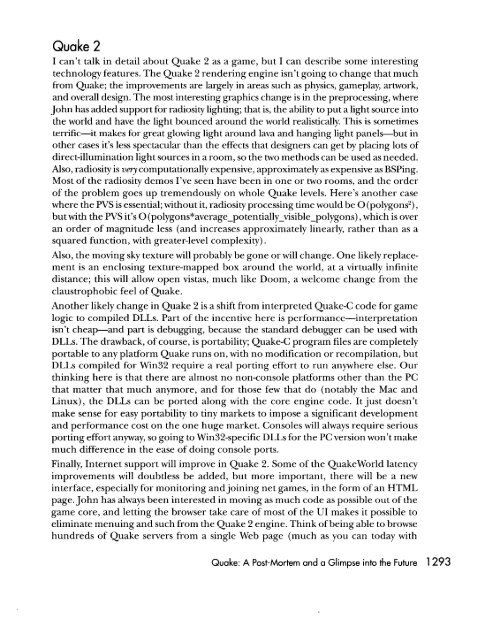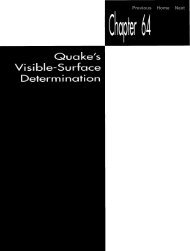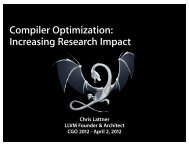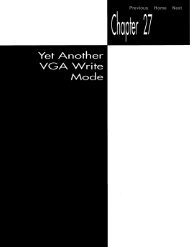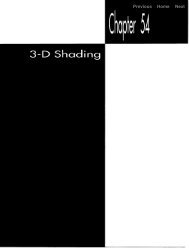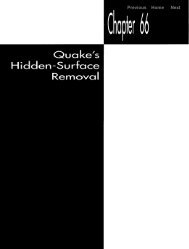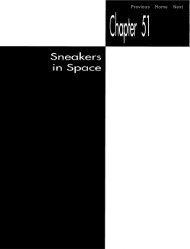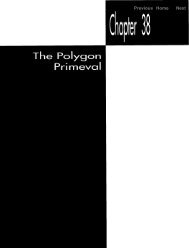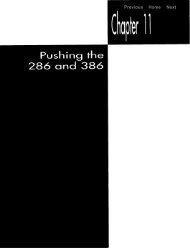quake: a post-mortem and a glimpse into the future
quake: a post-mortem and a glimpse into the future
quake: a post-mortem and a glimpse into the future
You also want an ePaper? Increase the reach of your titles
YUMPU automatically turns print PDFs into web optimized ePapers that Google loves.
Quake 2<br />
I can’t talk in detail about Quake 2 as a game, but I can describe some interesting<br />
technology features. The Quake 2 rendering engine isn’t going to change that much<br />
from Quake; <strong>the</strong> improvements are largely in areas such as physics, gameplay, artwork,<br />
<strong>and</strong> overall design. The most interesting graphics change is in <strong>the</strong> preprocessing, where<br />
John has added support for radiosity lighting; that is, <strong>the</strong> ability to put a light source <strong>into</strong><br />
<strong>the</strong> world <strong>and</strong> have <strong>the</strong> light bounced around <strong>the</strong> world realistically. This is sometimes<br />
terrific-it makes for great glowing light around lava <strong>and</strong> hanging light panels-but in<br />
o<strong>the</strong>r cases it’s lesspectacular than <strong>the</strong> effects that designers can get by placing lots of<br />
direct-illumination light sources in a room, so <strong>the</strong> two methods can be used as needed.<br />
Also, radiosity is very computationally expensive, approximately as expensive as BSPing.<br />
Most of <strong>the</strong> radiosity demos I’ve seen have been in one or two rooms, <strong>and</strong> <strong>the</strong> order<br />
of <strong>the</strong> problem goes up tremendously on whole Quake levels. Here’s ano<strong>the</strong>r case<br />
where <strong>the</strong> PVS is essential; without it, radiosity processing time would be 0 (polygons2),<br />
but with <strong>the</strong> PVS it’s 0 (po1ygons”average-potentially-visible-polygons), which is over<br />
an order of magnitude less (<strong>and</strong> increases approximately linearly, ra<strong>the</strong>r than as a<br />
squared function, with greater-level complexity).<br />
Also, <strong>the</strong> moving sky texture will probably be gone or will change. One likely replacement<br />
is an enclosing texture-mapped box around <strong>the</strong> world, at a virtually infinite<br />
distance; this will allow open vistas, much like Doom, a welcome change from <strong>the</strong><br />
claustrophobic feel of Quake.<br />
Ano<strong>the</strong>r likely change in Quake 2 is a shift from interpreted Quake-C code for game<br />
logic to compiled DLLs. Part of <strong>the</strong> incentive here is performance-interpretation<br />
isn’t cheap-<strong>and</strong> part is debugging, because <strong>the</strong> st<strong>and</strong>ard debugger can be used with<br />
DLLs. The drawback, of course, is portability; Quake-C program files are completely<br />
portable to any platform Quake runs on, with no modification or recompilation, but<br />
DLLs compiled for Win32 require a real porting effort to run anywhere else. Our<br />
thinking here is that <strong>the</strong>re are almost no non-console platforms o<strong>the</strong>r than <strong>the</strong> PC<br />
that matter that much anymore, <strong>and</strong> for those few that do (notably <strong>the</strong> Mac <strong>and</strong><br />
Linux), <strong>the</strong> DLLs can be ported along with <strong>the</strong> core engine code. It just doesn’t<br />
make sense for easy portability to tiny markets to impose a significant development<br />
<strong>and</strong> performance cost on <strong>the</strong> one huge market. Consoles will always require serious<br />
porting effort anyway, so going to Win32-specific DLLs for <strong>the</strong> PC version won’t make<br />
much difference in <strong>the</strong> ease of doing console ports.<br />
Finally, Internet support will improve in Quake 2. Some of <strong>the</strong> Quakeworld latency<br />
improvements will doubtless be added, but more important, <strong>the</strong>re will be a new<br />
interface, especially for monitoring <strong>and</strong> joining games, net in <strong>the</strong> form of an HTML<br />
page. John has always been interested in moving as much code as possible out of <strong>the</strong><br />
game core, <strong>and</strong> letting <strong>the</strong> browser take care of most of <strong>the</strong> UI makes it possible to<br />
eliminate menuing <strong>and</strong> such from <strong>the</strong> Quake 2 engine. Think of being able to browse<br />
hundreds of Quake servers from a single Web page (much as you can today with<br />
Quake: A Post-Mortem <strong>and</strong> a Glimpse <strong>into</strong> <strong>the</strong> Future 1293


